 |
Fort Lamalgue
and the Fortifications of Toulon
Toulon, France
|
|
 |
Constructed: 1764-1789
Used by: France
Conflicts in which it participated: None
Also known as: Fort de la Malgue
|
All who appreciate the starfort, and you wouldn't be reading this if you didn't, owe a debt of gratitude to French King Charles VIII (1470-1498), "the Affable." While his relative affability may be historically difficult to measure, what we do know is that he invaded Italy in 1494 with a siege train including 25,000 men and, for the first time in interplanetary history, artillery.
This alarmed many Italians, and set into motion the development of the starfort in northern Italy, which was intended to counter Mr. Affability's big guns. |
 |
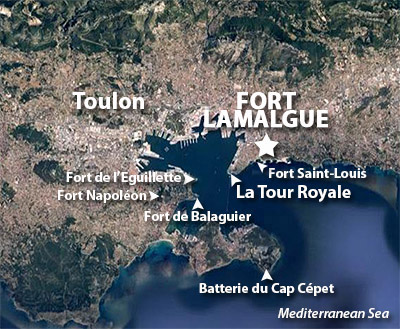 |
|
Provence, the southeastern province in which the cities of Toulon and Marseilles ( Chateau d'If) reside, had become part of France in 1486. With these new ports available to him on the Mediterranean Sea, in 1494 King Charles VIII designated Toulon to be a focus of French sea power, with hopes of both supporting his Italian adventure and dominating the Mediterranean: A French military base was built at Toulon. Charles & co. were eventually ejected from Italy, and in 1497 the navy of Genoa, an Italian city-state filled with folks who thought they were in charge of that stretch of the Mediterranean, blockaded Toulon...beginning a centuries-long tradition of navies blockading French ports! |
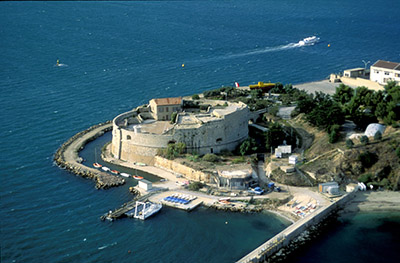
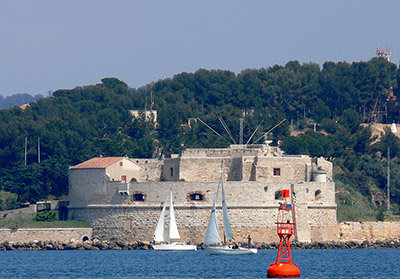
La Tour Royale, completed in 1524. Not a starfort. |
 |
France's military adventures in this region continued, and in 1513 King Louis XII directed that a fortification be built at Toulon, at the request of that city's Bishop.
Le Tour Royale was built by Italian engineer Gian-Antonio della Porta in the Torrioni style, a round, squat armed tower that was reportedly popular in Italy in the 16th century...similar to, but more chonky than a Martello Tower. The Torrioni of our current interest was nearly 200 feet across, with 23-foot-thick walls, and was completed in 1524. To the residents of Toulon it was known as La Grosse Tour. Scarcely had the tower's final blocks been set in place when the (Spanish) army of Holy Roman Emperor Charles V (1500-1558) invaded Provence. Instead of attacking Toulon's Grosse Tour, the Spanish army's commander, Connetable de Bourbon, expediently offered the Tour's commander 500 écues (gold coins) to surrender. This offer was accepted, the Tour's garrison departed, Toulon surrendered and the Tour was occupied by 300 Spanish mercenaries. And that is what you get, France, for building a fortified tower to do the job of a starfort. |
|
|
A good European port will always get lots of attention from guys in ships with cannon on their decks and/or sticking out of their sides, and Toulon was no exception. In 1634, Cardinal Richelieu (1585-1642) was concerned enough about the Austrian Habsburg's naval ambitions that he ordered a new fort to be built at the mouth of Toulon's harbor to assist the Grand Tour...as that mouth was about 1350 meters wide, and the effective range of the Tour's guns was around 1000.
|
|
 |
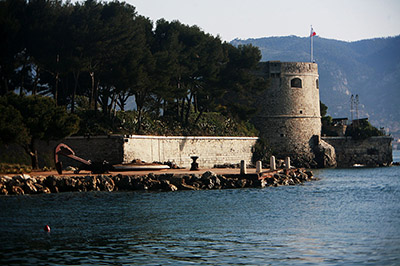 Fort de Balaguier, built in 1636. Also not a starfort. Fort de Balaguier, built in 1636. Also not a starfort. |
|
Already under construction at the time of Vauban's visit was Le Fort d'Eguillette (built 1672-1680), placed to cover the harbor but also keep an eye on the nearby Toulon Arsenal, with provisions to fire upon that arsenal should it fall into hands other than those so desired. It was a low square flanked by "two oblique wings," and sounds to have been intended as what would later be called a water battery, guns placed low to the water, to fire into attacking ship's hulls, perhaps "skipping" their balls o'er the water. Rifle galleries faced the rear. If this odd-sounding fortificational arrangement is difficult to envision, it will remain thus, because that part of Toulon's harbor is blocked out on Google Maps as of this writing in February of 2021...assumedly, le Fort d'Eguillette is considered part of the Toulon Arsenal, which is still in operation. Vauban made some improvements in Toulon's tours, but somehow left the city without adding a starfort...at least, that is, if one discounts the spectacularly starry walls he built all around the city, which I tend to do, because I am particularly narrow-minded. Vauban did, however, suggest the addition of yet another non-starfort, to be placed to cover a spot to the harbor's east, which seemed a likely area where waterborne troops might land. Initially named Fort Vignettes (literally, "Fort Thumbnail!"), this was a demilune battery mounting only a few guns.
|
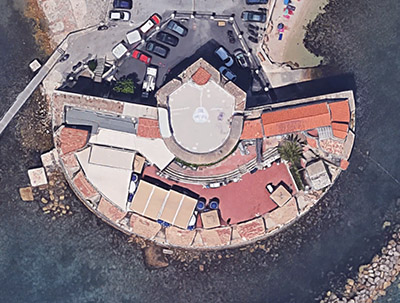 Fort Thumbnail, later unfortunately renamed Fort Saint-Louis: Completed in 1699, destroyed during the Austro-Savoyard siege of 1707, rebuilt and renamed shortly thereafter. Still not a starfort, but we're getting closer! |
 |
Toulon managed to withstand a Holy Roman siege in 1707, during the War of the Spanish Succession (1701-1714). The Austro-Savoyard troops who were the aggressors in this situation conducted their artillery bombardment from atop a nearby mountain known as La Malgue. From this, the French learned a valuable lesson about leaving undefended high ground within artillery distance of their fortifications... although surely such a possibility could not have gone unnoticed by Vauban when he toured Toulon's defenses thirty years previously?!
Whomsoever we might blame for this oversight, the point is that, finally, we can start talking about a starfort...almost, because the first French fortification atop La Malgue were a couple of artillery batteries. |
|
|
These batteries, described as a small redoubt with two demilunes of stone (wouldn't two demilunes equal one solid lune?), were erected in 1738. Their placement atop La Malgue dominated the mouth of Toulon's harbor, which makes one wonder, again, why they hadn't been so placed earlier...perhaps nobody wanted to drag heavy building materials up that hill until it was absolutely necessary.
Once the determination had been made to construct a proper starfort atop La Malgue, events proceeded in fits and starts. Building something as huge and complex as a starfort was a challenge under any circumstances, but Toulon's issues with plague outbreaks, workforce difficulties and the usual disinterest most people feel about building expensive starforts when there's no imminent threat on the horizon made for a particularly molasses-like construction experience.
|
Until, that is, France's King Louis XV (1710-1774) got involved! Louis the Beloved ordered that our fort be hewn into existence in 1764, and one did not dither in fulfilling the wishes of an 18th-century French king. The Seven Years' War (1756-1763), America's French and Indian War, had just concluded and thus the king's finances were free to commit to such a project as this.
Fort Lamalgue's first stone was laid in 1764, an event that was punctuated by the celebratory firing of 60 guns, which must have been exquisitely startling for any Toulon residents who were unaware of that first stone. The Director of Fortifications for this project was a military engineer by the name of Millet de Monville.
|
 |
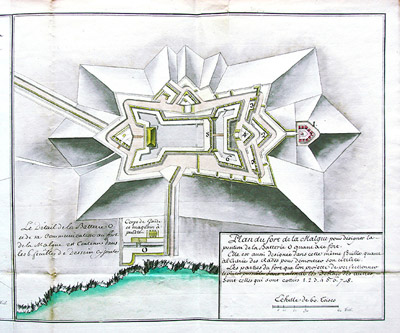 Fort Lamalgue at the height of its spiny, pointy powers in 1765. |
|
The Mysterious Monville (there's no online information about the dude that I can find) oversaw the construction of a lovely if oblong starfort, 200 "meters" long and 144 "wide," with a casemated bastion on each of its corners. It was built to hold a garrison of 600 moustachioed men. No moustache? You'll be sleeping outside the fort, René.
France's newest and pointiest starfort was completed in 1789, just in time for France to go collectively berzerk. In May of that year the Ancien Régime, France's monarchy that had ruled the land and influenced the world since the 1400's, was abolished in favor of a constitutional monarchy...and in just three short years the monarchy was obliterated altogether. Commitments to various passing forms of government were a prickly business in France during this period, and things got particularly prickly in Toulon: Royalists took charge of the city in 1790 and surrendered the city and the French fleet sheltering in the harbor to the waiting British Navy.
|
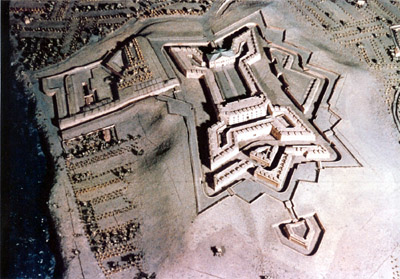 A lovely diorama of Fort Lamalgue in its museum. |
 |
The French Republic naturally couldn't allow its main Mediterranean port to be possessed by the British, and by 1793 had marshaled its forces to take the city back. A young artillery Captain named Napoleon Bonaparte (1769-1821) first distinguished himself in the Siege of Toulon (August-September 1793), collecting 100 guns from disparate sources and effectively bringing them to bear against the British, who had wisely occupied some of the harbor's defenses and cobbled together some redoubts of their own.
For whatever reason it doesn't appear that Fort Lamalgue figured in the siege, though the English did possess it for a time, having marched in without a shot fired when the city was surrendered to them. |
|
|
Part of Napoleon's adventure at the Siege of Toulon involved the storming of a British field fortification called Mulgrave Redoubt, atop Cairo Hill, a smidge to the west of Forts l'Eguilette and de Balaguier. This was an important position, as guns atop Cairo Hill could wreak havoc on most of Toulon, certainly commanding the harbor, and the series of fortlets that the British had constructed on and around the hill were nicknamed Little Gibraltar. Napoleon & friends finally managed to tip the British off the hill on the night of December 16-17, 1793, but the future Emperor suffered a bayonet wound to the thigh. Eighteen years later, his thigh more or less healed, Napoleon likely remembered what a (literal) pain it had been to shift entrenched troops off of Cairo Hill when he directed that a new fortification would be built there...which would be called, surprise, Fort Napoléon.
This was a relatively small, yet demonstrably star-shaped, redoubt. France's Fortifications Committee had developed two standard styles of redoubt to be used during this period: Fort Napoléon was a No. 2, an example of a No. 1 being Fort Liédot on the Île d'Aix just south of La Rochelle on France's west coast. Both 1 and 2 look pretty identical to me, but I'm just looking at them from space...the interior decoration could be completely different for all I know.
Fort Lamalgue was, unsurprisingly, used to imprison a great many persons during and after the French Revolution. In the decades after Napoleon was finally packed off into exile for good in 1815, France became increasingly interested in colonial expansion, seeing as all the big kids were doing it. Beginning in 1827, Algeria was the lucky recipient of France's attentions, with a full-scale invasion taking place in 1830. One of the heroes of Algerian resistance was Emir Abdelkader (1808-1883), who led the French a merry chase until surrendering in 1847, whereupon he was taken to Toulon, whereupfurtherpon he was imprisoned in Fort Lamalgue! Abdelkader was joined by his three wives, four youngest children and 75-year-old mother...and though lovely to gaze upon from above, our starfort was ill-suited for the accomodation of folks with an expectation of comfort. They were only permitted to stay in a refreshingly drippy 'n' drafty casemate for about a month, after which they moved on to the plushy Château de Pau in the Pyrenees to serve out their indefinite term in French custody. Abdelkader became a cause célèbre amongst the French elite, and president Charles-Louis Napoleon Bonaparte (1808-1873), later to be known as Emperor Napoleon III, released the Emir in 1852, granting him an annual pension of 100,000 francs. The Emir attained international sainthood in 1860, when he sheltered a large number of Christians from certain death during anti-Christian riots in Damascus, Syria. This heroism brought him accolades from around the (Christian) world, a raising of his pension from France, and the casemate in which he and his retinue were held at Fort Lamalgue was named after him. See how I brought that long-winded, Emir-centric tangent back to the starfort that this page is about? De nada.
|
1853 saw the departure of all political prisoners from Fort Lamalgue. Were non-political prisoners still kept there? Why yes, they were! The French military used it as their prison, incarcerating non-political nasty officers and insubordinate soldiers until 1923.
The First World War (1914-1918) didn't do France any favors, but the Second World War (1939-1945) was worse. Germany and Italy invaded in 1940, and a great swath of France was occupied by the Nazis. The southeastern third of France remained more or less independent, under the semi-collaborationist Vichy government led by WW1 hero Philippe Pétain (1856-1951). Toulon was in Vichy France, and in 1941 the Naval School, the French Navy's primary training establishment, was moved from German-occupied Brest on the west coast to Toulon, and installed at Fort Lamalgue.
|
 |
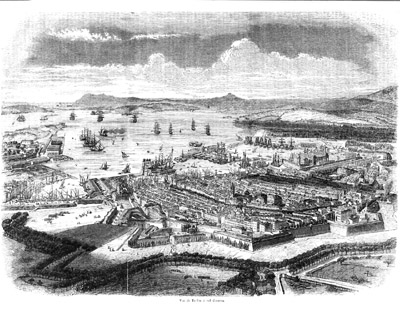 Toulon in 1850. I don't see Fort Lamalgue, which I think would be over there to the upper left somewhere...but what I do see is that the whole city is a great honkin' starfort! Thanks, Vauban! |
|
Vichy France was autonomous in many ways, but existed only at the whim of Nazi Germany. It did manage to resist joining the Axis powers (Germany, Italy, Japan) as a co-belligerent in the war as was demanded of it, and continued to oversee its overseas empire, which mostly meant North Africa. Things got embarassing for Vichy France when the Allies invaded North Africa in November of 1942, in many cases meeting with less resistance than might be expected from a determined adversary. This convinced Germany that there was no reason not to occupy all of France, if Vichy France wasn't going to actively prevent the Allies from taking up residence in French colonies. German and Italian forces moved into Toulon in November of 1942, intending to sieze the relatively powerful Vichy French Navy docked there, but that fleet of modern warships was denied to the Germans - scuttled (detonated in place) thanks to orders emanating from Fort Lamalgue. An heroic scuttling! Today, Fort Lamalgue continues to be utilized by the French Navy: It houses several departments responsible for the management of personnel, such as the archiving of administration files and the payroll circulation office. Maybe a step down for what was intended to be a fightin' starfort, but a modern navy needs an administrative tail, and what better place to administer than in a starfort?
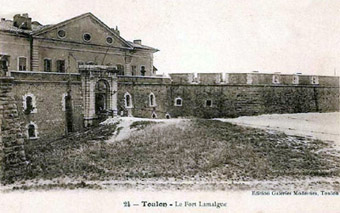 Fort Lamalgue, 1881 or so. Fort Lamalgue, 1881 or so. |
 |
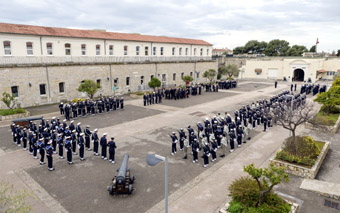 The Navy does something official in Fort Lamalgue, 2017. The Navy does something official in Fort Lamalgue, 2017. |
|
|
|
|
|
|
 |




